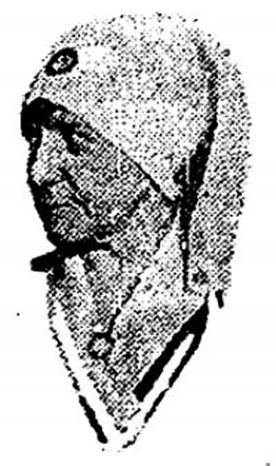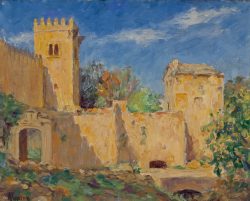Anna Lynch, from a photograph reproduced in Chicago Tribune, Nov. 29, 1920, courtesy of Joel Dryer.

Anna Lynch 1865–1946
Anna Lynch was born in Elgin, Illinois, and attended the Art Institute of Chicago, studying with John Vanderpoel. Lynch first showed her miniature portraits in the Art Institute’s 1897 annual exhibition for watercolors, pastels, and miniatures; she would be represented there and in the museum’s annual exhibition for Chicago artists (later dubbed the “Chicago and Vicinity” exhibition) for more than thirty years. In 1902 Lynch went to Paris to enroll in the Académie Julian, where her teachers included famed figure and portrait painter William-Adolphe Bouguereau and miniature painter Gabrielle Debillemont-Chardon. Lynch showed her works in the Paris Salon exhibitions of 1903 and 1904, returning to Chicago in 1905. Late the following year the Art Institute staged a well-received solo exhibition featuring her miniature portraits of sitters from around the country. Lynch also exhibited widely beyond Chicago. In 1910 she showed in the annual exhibition of the Pennsylvania Society of Miniature Painters; in the 1915 Panama-Pacific International Exposition in San Francisco she won a bronze medal. In 1921 Lynch was a founding member of the Chicago Society for Miniature Painters, and she served as its first president.
Beginning in 1908, Lynch maintained a studio in the Tree Studios building on Chicago’s Near North Side. She was known particularly for her miniature portraits of children, but as the popularity of the medium waned she also painted full-size commissioned portraits of adults as well as floral still-life images. In 1925, her widely reviewed solo display at the Art Institute included numerous landscape and marine paintings, many the fruits of a recent trip to France and Spain; she returned to Spain again in 1929. Lynch was a professional member of the Arts Club of Chicago, a pioneering organization that helped introduce modernist art to the city. But she also associated with Chicago’s conservatives, showing with the Chicago Society of Painters and Sculptors and the Society for Sanity in Art as well as the Chicago Galleries Association. Lynch’s 1930 solo exhibition at the Cordon Club won the praise of the Chicago Tribune’s conservative critic Eleanor Jewett, who described her as “being one of the imposing band of Chicago artists who have not yielded an inch to modernist importunity.”i
Wendy Greenhouse, PhD
i Eleanor Jewett, “‘Step on the Gas,’ Boy’s Plea; Artist Shows the Portrait,” Chicago Tribune, Jan. 6, 1930.
